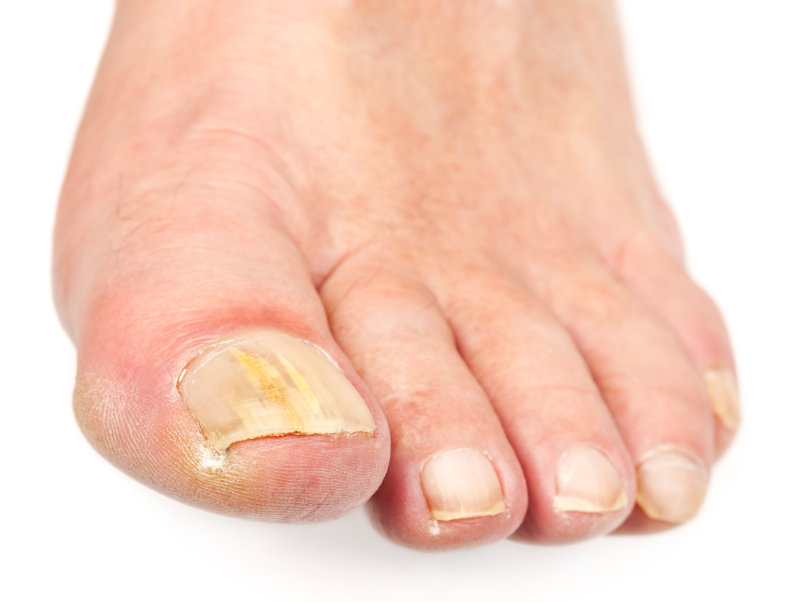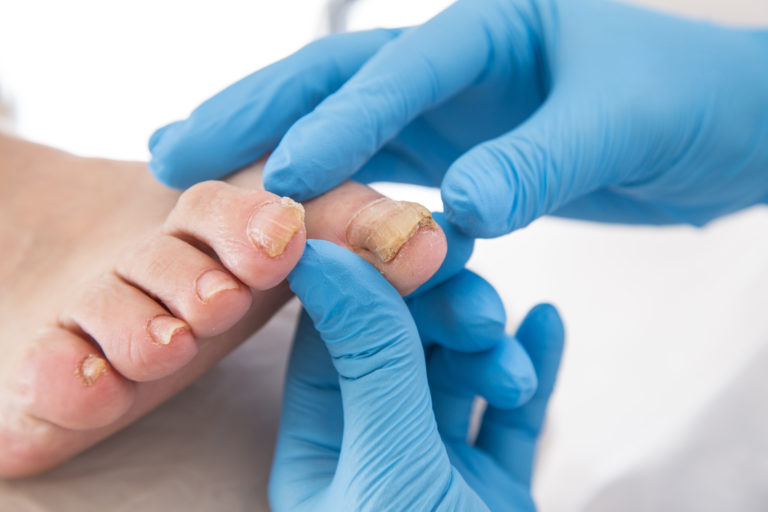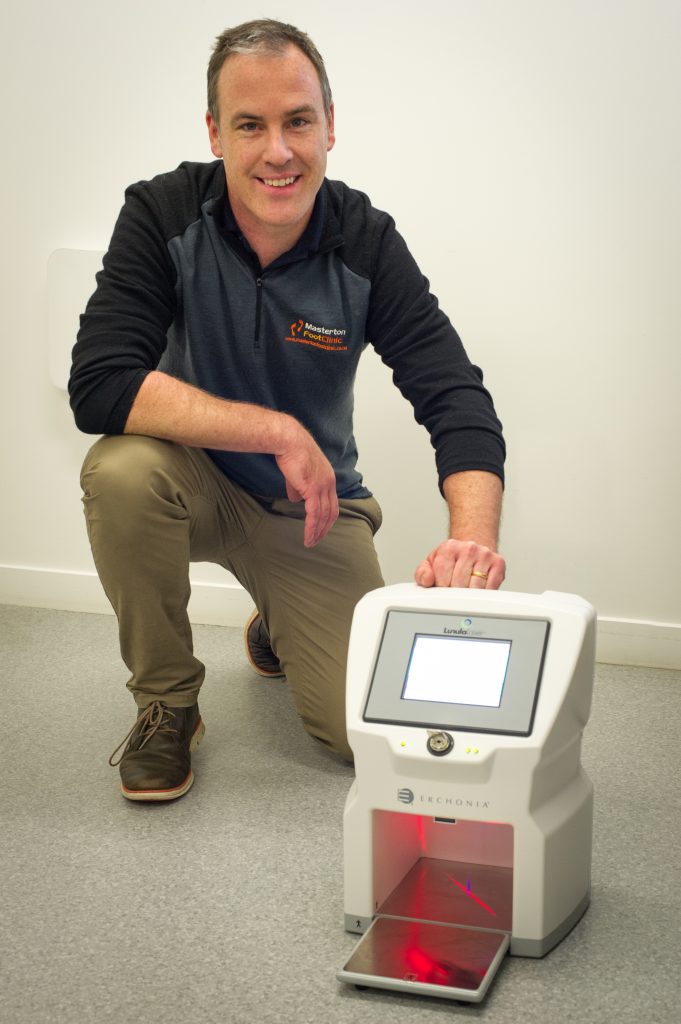 Fungal nail infections that leave the nail discoloured, flaky and deformed are one of the most common problems we see here at Masterton Foot Clinic. Research has shown that fungal nail infections affect up to 23% of people, and are the cause of 50% of all nail diseases, with the toes being affected in 4 out of 5 people. While some fungal nail infections can cause the nail to become thick and uncomfortable, especially when wearing narrow shoes, for many it affects their self-esteem and confidence in wearing open-toed shoes or showing their feet at the beach.
Fungal nail infections that leave the nail discoloured, flaky and deformed are one of the most common problems we see here at Masterton Foot Clinic. Research has shown that fungal nail infections affect up to 23% of people, and are the cause of 50% of all nail diseases, with the toes being affected in 4 out of 5 people. While some fungal nail infections can cause the nail to become thick and uncomfortable, especially when wearing narrow shoes, for many it affects their self-esteem and confidence in wearing open-toed shoes or showing their feet at the beach.
Why do fungal nail infections start?
Medically referred to as onychomycosis, fungal nail infections start when a fungal spore comes in contact with the nail and penetrates it. From here, the infection gradually grows and spreads through the nail, feeding on the keratin that nails are made of.
Not everyone that comes in contact with fungal spores will get an active infection, and for some, their bodies may clear the infection before it has a chance to produce changes to the nail. If your nail is weakened like from trauma, if you have poor circulation, or if your immune system isn’t at 100%, you may be more susceptible to an infection taking hold.
The most common places to ‘pick up’ the spores are from public swimming pools, changing rooms, nail salons and the like. This is because fungus thrives in warm and moist environments, making it easier to spread and come in contact with as you don’t know if the person in the shower before you had a fungal infection or not. Once the infection starts, wearing enclosed footwear, sweaty socks and wet feet will encourage it to grow quickly.
Fungal nail infections can and do spread through families – so if your partner has a fungal nail infection, there’s a good chance that you may develop it too over time.
How do I know if it’s a fungal nail infection or something else?
 Fungal infections are common, and can usually be detected by the changes to the appearance of the nail that tendon to worsen over time – and even spread to the other toes. Your nails can become:
Fungal infections are common, and can usually be detected by the changes to the appearance of the nail that tendon to worsen over time – and even spread to the other toes. Your nails can become:
- Discoloured – yellow/white/brown
- Thick
- Flaky
- Brittle with a moth-eaten appearance
- Odorous
- Spotted or streaked
Your nails may also change shape, with the nail starting to lift away from the base of the nail.
When it’s not a fungal nail infection, the cause of the change in appearance to your nail may be from psoriasis, onychogryphosis (causing nail thickening and distorting the shape of the nail), lichen planus, carcinomas, melanomas – as well as simple injury to the nail like from kicking the table or dropping something on the toe.
Here at Masterton Foot Clinic, we don’t believe in guesswork when it comes to fungal nail infections. Before starting your anti-fungal nail treatment, we perform a quick test in the laboratory to confirm the presence of nail fungus. This test takes approximately five minutes, and ensures that you don’t waste time and money on anti-fungal treatments for the wrong condition.
Treating fungal nail infections

Treating fungal nail infections can be a lengthy, frustrating and costly process. Standard treatments like creams and lacquers from the pharmacy have shown a poor success rate in studies – ranging from between just 5.5% and 8.5%. Prescription oral medications have a higher success rate of between 14% to 55%, but carry risks of adverse effects and are unsuitable for many patients, as determined by their GP.
After seeing patients struggle for years with no real reliable solution, we’re pleased to say that we were the first in New Zealand to pioneer the world’s leading anti-fungal treatment – the Lunula cold laser.
Cold laser has no side effects, no pain, is safe, simple, and effective. It has clinically proven success rates of between 83% and 97% after four treatments. We improve this by providing everything you need to reduce the risk of reinfection at home, including being just a phone call away from our highly-skilled team that specialises in the cold laser treatment of fungal nails.
We’ve shared everything you need to know about the Lunula laser here.
FAQs
Why have I developed a fungal nail infection?
Having a fungal nail infection means that at some point, you will have come into contact with fungal spores, whether that’s from direct contact (like with someone that has a fungal nail infection) or from sharing surfaces (like sharing showers with someone that has a fungal nail infection, whether that’s a public shower or at home). Circumstances mean that the infection has been able to take hold, and the fungus has started affecting your toenails and making changes to their appearance.
If I have my nail fungus treated, can it come back?
Just like stubbing your toe twice, it is possible for you to pick up another fungal nail infection. But just like wearing sturdy shoes to avoid stubbing your toe that second time, we provide you with the right tools and information to reduce this risk to the best of our ability.
As leading experts in this field in New Zealand, we equip you with everything you need to minimise this risk as much as possible. We provide Hygiene and Re-infection guides that outline everything you need to know about fungal nail infections, where you’re at risk of picking them up and how to avoid them. If there is anything you’re uncertain of, our expert team will be happy to answer all of your questions and is just a phone call away.
How is nail fungus spread?
Fungus reproduces and spreads through microscopic spores. These spores spread to surrounding surfaces through the air and can land on the skin and nails. When conditions are suitable, the fungus will grow and infect the nails.
Ideal conditions for fungal growth are dark, warm and moist environments. This is why closed footwear and sweaty feet are ideal for fungus to grow and thrive. Showers are also a common area where fungus spreads and infects the feet.
If I’m treating my nail fungus, should my family be treated too?
The British Association of Dermatology recommends that family members be assessed and if infected, be treated at the same time to avoid reinfection. If you have a fungal nail infection, there’s a good chance that your family members do too because of the surfaces you share like floors and showers, where fungus often spreads.
If you bring them in, we can check their feet and nails for any signs that an infection has started to form, free of charge. Having everyone that is at risk treated reduces the risk of reinfection.
Does toenail fungus require treatment?
Toenail fungus can spread to others in your household and cause unpleasant changes in the appearance of your toenails. For these reasons, most people choose to have them treated. Leaving fungal nails untreated won’t cause you systemic harm, but the effects of the fungus will continue to worsen.
Can I keep wearing the same shoes and socks during my fungal treatment?
We have a tool that disinfects your shoes at your appointment with us, so you can keep wearing these. For socks, we recommend you either wear new socks or hot wash existing socks with an antifungal agent to destroy the fungus and spores present in your socks. This significantly reduces your risk of re-infection.
How do I know if I have toenail fungus or something else?
Toenail fungus often starts with white spots or streaks on the nail that worsen and develop and yellow discolouration over time. The nails can then become brittle, thick, rough and have a moth-eaten appearance. Some of the symptoms of fungal nail infections are similar to psoriasis and some other conditions, which is why we have a 10-minute in-clinic test to confirm that your infection is caused by fungus. This involves testing a sample of the infected nail. We can do this during your appointment.
